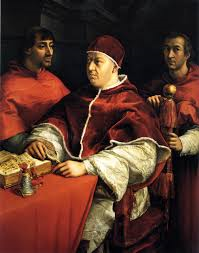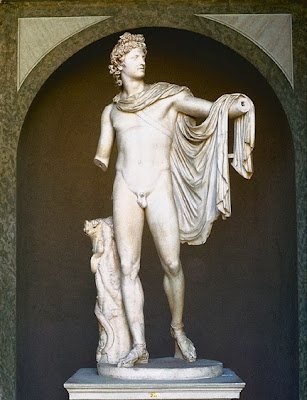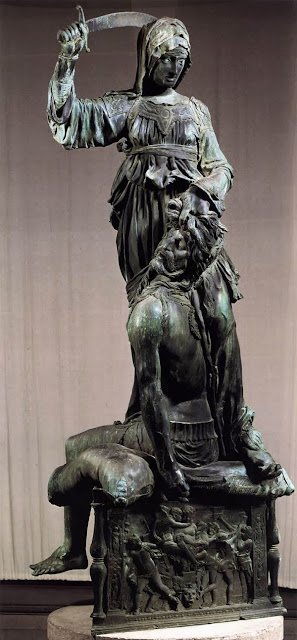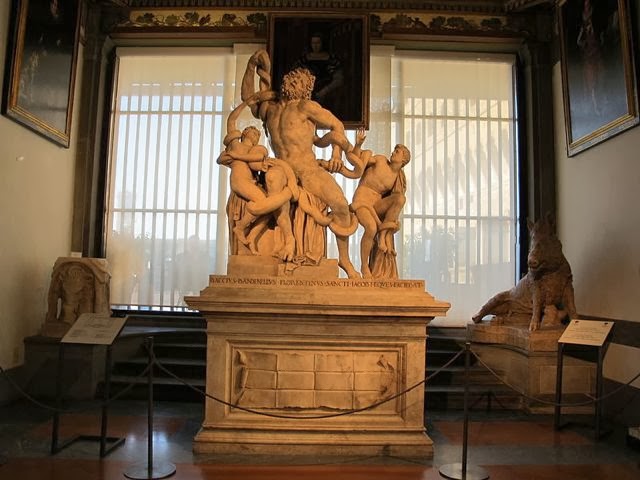The Laocoon Group, marble copy by Baccio Bandinelli after the Hellenistic original
With the reorganisation of the Uffizi gallery, the exit is no longer mid-way down the third corridor, but at the end of it. This brings the Laocoon sculptural group, a 1500s copy of the famous ancient sculpture, once more as a protagonist in the gallery. Located at the end of the third corridor, previously overlooked by most, visitors to the gallery are now forced to walk right up to it in order to leave the building.
This copy was commissioned to Baccio Bandinelli by Cardinal Giulio de Medici in the early 1500s. It was originally intended to the be sent as a gift to the French king Francis I, however this was never followed through. The sculpture stayed in Florence where it was displayed for centuries in the garden of the Medici home on via Larga (modern day via Cavour).
 |
| Raphael, portrait of Pope Leo X with cardinals Giulio de Medici and Luigi de Rossi, 1518-1519, Uffizi Gallery |
The eponymous protagonist of the sculptural group is an Apollon priest of Troy who is depicted, along with his two sons, being strangled by sea snakes. This ill fated death was sent by Neptune and Athena who wished to stop Laocoon from persuading his fellow Trojans to refuse the gift of the wooden horse from the Greeks. Laocoon had understood that this was a clever ruse on behalf of the Trojans’ enemy, the Greeks, to enter the city and that there were no good intentions about it. The gods wanted the Greeks to win and so they were making sure that nothing prevented the outcome that they desired.
The original sculpture, from which the group in the Uffizi gallery is a direct copy, is thought to be from the 1st century BC from Rhodes. Pliny the Elder (AD23-AD79), the Roman historian, named three sculptors responsible for the group, Agesander, Athenodoros and Polydorus. Its fame spread far and wide upon its creation and much was written about it, with great praise. Centuries later in the renaissance period, this original sculptural group was unearthed on 14 January in 1506, in the area close to Santa Maria Maggiore in Rome. Pope Julius II immediately claimed it as papal property and the sculptural group was placed in the Belvedere courtyard in the Vatican palace, where it remains today.
The sculpture became one of the most influential works of the century. Artists from far and wide came to draw it and etchings were sent to courts all over the continent. The deep pathos, drama and intense emotion of the figures, particularly expressed by Laocoon himself, opened up new avenues of expression in the renaissance world.
 |
| Head of Laocoon, detail of Laocoon Group |
The rational renaissance, full of self control and restraint, is forgotten when looking at this most highly charged work. It is an exemplary work of the Hellenistic period, which succeeded Classicism.
In the Belvedere courtyard of the Vatican museums, home to the original Laocoon, there is also the Apollo Belvedere sculpture, one of the other most beautiful sculptures in the collection, and which embodies the qualities of the classical period. In this sculpture, all emotion is contained and internalised and nothing but calm confidence resonates from the god who has just shot an arrow from is bow (now lacking). The placements of the two great sculptures in the Belvedere courtyard means that you don’t have to move to be able to see them both very well, each of them individually occupying a deep recess in the courtyard but close to one another. Each work perfectly embodies the characteristics of the two most important and strongly different styles from antiquity – Classicism and Hellenism.
 |
| Apollo Belvedere, Roman copy after a Greek bronze |
The Laocoon copy by Bandinelli in the Uffizi was commissioned in 1520 by the future second Medici pope, Cardinal Giulio de Medici. The patronage is evident because of the cardinal’s symbol on the original pedestal underneath. Paolo Giovio, an intellectual from Como living in Florence was responsible for the cardinal’s impresa (personal motto and symbol), a transparent crystal ball through which a ray of sunlight shines and hits a tree setting it alight. The motto is ‘candor illesus’ (purity unharmed).
The sculptural group was commissioned in Rome by the Cardinal for his cousin, Pope Leo X, who wished to gift it to King Francis I of France. After Pope Leo X’s death in 1521, Bandinelli and Cardinal Giulio living in Rome, returned to Florence leaving the marble in Rome. Upon Giulio’s election to Pope in 1525, they both returned to Rome and Bandinelli resumed work on the Laocoon group. Giulio, now Pope Clement VII, no longer had plans to send the work to France, but instead sent it to the Palazzo Medici for the garden. It replaced the bronze Judith and Holofernes group by Donatello which had once been in the garden of the Medici palace but was then taken to the town hall (where it is today) when the family was exiled in 1494.
 |
| Donatello, Judith slaying Holofernes, bronze, late 1450s, Palazzo della Signoria |
When the Laocoon arrived in the Medici palace garden, there was already another work by the Bandinelli located in the courtyard, the Orpheus statue, which had been there since 1519. It too replaced a work by Donatello, the famous bronze David commissioned by Cosimo the Elder. Once located in the centre of the courtyard, it too had been taken to the town hall after the family’s exile. Interestingly, Bandinelli’s Orpheus deliberately draws inspiration from the above mentioned ancient Apollo Belvedere statue which, discovered in the late 1400s, had been in the Vatican courtyard since 1511. Bandinelli would have had ample opportunity to draw and study it.
 |
| Baccio Bandinelli, Orpheus, 1519, marble, Palazzo Medici-Riccardi |
Just as, in the Vatican, the Laocoon and Apollo are still today in close proximity, the copy of the Laocoon and the Orpheus (inspired by the Apollo), both by Bandinelli from the same patron, were in the same location, the Medici palace,
 |
| Donatello, David, 1440s, bronze, Bargello National Sculpture Gallery |
Unlike Orpheus however, after the sale of the palazzo to the Riccardi family in 1659, the Laocoon was transferred to the Casino di San Marco and then entered the Uffizi with the legacy of Cardinal Carlo de Medici.





